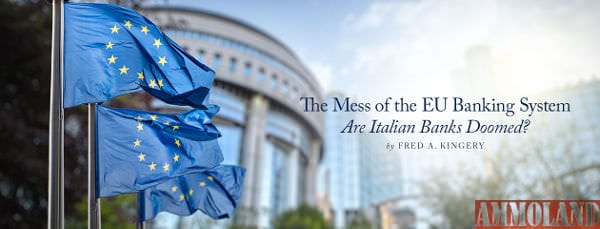by Fred A. Kingery


Grove City, PA -(Ammoland.com)- In January, European Union (EU) bureaucrats based in Brussels passed an EU banking reform referred to as the BRRD. The BRRD stands for Banking Recovery and Resolution Directive.
The reform rules were aimed at shielding EU taxpayers from bailing out troubled EU banks with taxpayer-sourced funding. The rules were modeled after the Cyprus banking crisis solution referred to as a “bail-in.” A bail-in is where bank bond holders and large bank depositors are all placed at the front of the line and used as funding sources to offset a write-down of bad bank loans. Taxpayer-based funding (a bailout) becomes a last resort.
What was significant about this is that for the first time bank depositors have been officially added to the list of funding sources for offsetting bad bank loans. Bank depositors all over the world took special note of this “bail-in.” The BRRD is a one-size-fits-all approach to dealing with EU problem banks if and when the time comes. Unfortunately, the time has come for Italy’s banking system but there is a major problem.
For perspective on the problem consider the following facts on the EU banking system:
- The U.S. GDP is roughly $18 trillion. The EU GDP (representing 27 countries) is slightly smaller. The U.S. banking system has assets approximating $16 trillion which is slightly smaller than the U.S. GDP. The EU banking system is a monster that holds over $45 trillion in assets. Stated another way, the EU GDP is slightly less than the US GDP but has a banking system about three times the size of the U.S. banking system.
- Within the EU, the German economy is the largest with a GDP of $3.35 trillion. German bank assets come in at 3.3 times German GDP (roughly $11 trillion). France GDP is number two at $2.41 trillion and has bank assets 4.1 times the French GDP (roughly $9.9 trillion). Italy’s GDP is number three at $1.81 trillion with an attached banking system that is 2.5 times GDP (roughly $4.5 trillion). The top three EU countries have combined bank assets of over $25 trillion, or 1.5 times bigger than the entire U.S. banking system.
- Carried on Italian bank’s books are non-performing loans (NPLs) of about $400 billion. These are loans not being serviced by the borrower and not written off the banks’ balance sheet—yet. Italian banks have the largest NPLs of any banking system within the EU. A write off of NPLs of this magnitude could destroy the capital adequacy of the entire Italian banking system. In effect, in a worst-case scenario, any attempt at a write off of this magnitude could cause a termination of all non-central bank funding of the entire Italian banking system and it would cease to function.
- Italian banks have issued about $200 billion in unsecured subordinated bond debt to Italian citizens. This debt is a significant portion of the banking system’s capital structure. These bond holders are also the same Italian taxpayers who the BRRD reform is supposed to protect from any banking crisis in Italy. However these taxpayers/bond holders have now been put at the front of the line to provide funding for any “bail-in” when the time comes. Making matters worse is the perception by the bond holder/taxpayer that the bank bonds they hold are as safe as a bank deposit which is not only now not true but would only be true if the depositor were a small one where “small” has yet to be defined.
See the problem. If you are an Italian bank bond holder or a bank depositor of some size, you have every right to be nervous. Very nervous.
There is an Italian election scheduled for October of this year that has nothing to do with Italian banking. This election is an attempt to reform the Italian constitution. The reform might help stabilize the future tenure of any elected government. Italy has had 63 different elected governments since World War II. The current Italian Prime Minister Matteo Renzi says he will resign if he doesn’t get the change to the constitution he is seeking. Usually the response to that threat would be a collective “so what.” However, currently waiting in the wings of Italian politics is a Eurosceptic movement called the Five Star Movement. Current polling shows that Five Star has the political strength to potentially win a snap election and form a new government in Italy. Part of the current appeal of the Five Star movement is to leave the EU, dump the Euro and return the Italian currency to the Lira.
When Brexit happened, it happened with the British Pound Sterling in place. All of British business and banking relationships were defined in its own currency. This feature of Brexit will make a transition of England out of the EU difficult but not impossible. Any Italian move out of the Euro or out of the EU will easily destroy the whole of the massive EU banking system.
Sometime between now and the October elections in Italy, Angela Merkel and the German people will have a critical decision to make. They will have to decide if Germany will offer its financial assistance in support of an Italian bank bailout. The decision to assist or not will have profound implications for all of the EU. It will signal a willingness to further integrate the entire EU experiment or not.
If Germany blinks, then the entire Italian banking system could unravel in a blink also.

About the Author:
Fred A. Kingery is a self-employed, private-equity investor in domestic and international financial markets and a guest commentator for The Center for Vision & Values at Grove City College.
